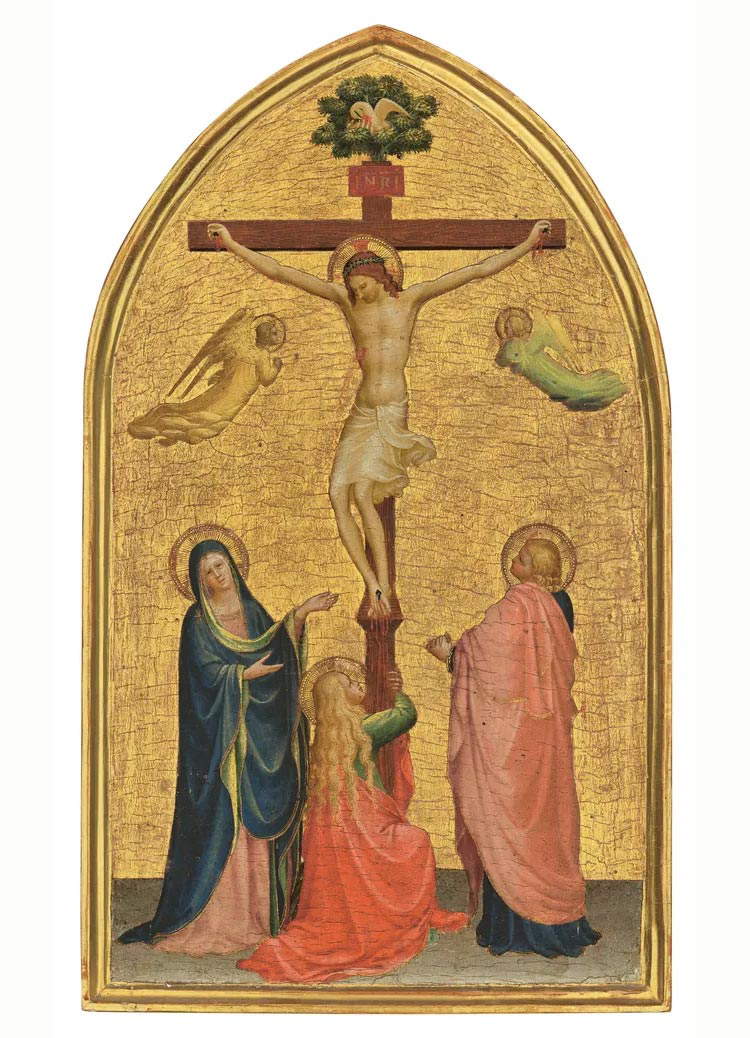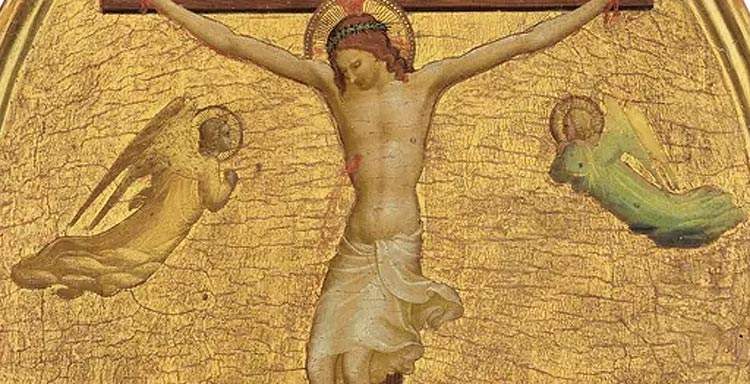Going up for auction at Christie’ s on July 6 with an estimate of between £4 million and £6 million (€4.6 million to €7 million) is a rare early Crucifixion by Fra Angelico: it will be the highlight of the Old Masters Part I Sale to be held during Classic Week in London. The panel, measuring 59 x 34 cm, was discovered and published in 1996 by Francis Russell, Christie’s current vice-president for the United Kingdom, who wrote an essay on the work published in the May 1996 Burlington Magazine, sparking widespread interest among scholars.
It is an early work, placed, by the six other scholars who have written about it (Diane Cole Ahl, Laurence Kanter, Giorgio Bonsanti, Gerardo De Simone, Ginevra Utari, and Carl Brandon Strehlke), between 1419 and 1424. Also in favor of the attribution is one of Beato Angelico’s leading experts, Angelo Tartuferi, who, moreover, will curate an exhibition on the artist at Palazzo Strozzi between 2025 and 2026 (and the panel in question may also be there). It was originally the central compartment of a devotional triptych whose patron we do not know. The early history of the work is not known. It is thought to have been acquired in the mid-19th century on the Italian market by a noble collector, Lord Ashburton, who died in 1864, and subsequently the work came to its present owners by descent. Works of this kind very rarely come on the market: since 2000 to date there have been only two works by Fra Angelico that have gone to auction (one last year at Christie’s in New York: it was a panel with St. Dominic and St. Francis, which sold for $4.7 million). The work will be on public view in New York from June 10 to 14, before returning to London for a display of the lots at Classic Week in London, which can be visited from July 1 to 6.

The work had previously been attributed to the school of Lorenzo Monaco, and according to Russell in favor of attributing it to Beato Angelico would play the central perspective of the cross, evidence that the author of the work was aware of the work of artists such as Filippo Brunelleschi and Lorenzo Ghiberti. Further evidence would come from St. John’s cloak, which would appear to be modeled in sculptural terms. Art historian Diane Cole Ahl has also noted that the saint’s features and posture were probably inspired by the character featured in the tile made by Ghiberti for the 1401 competition.
With only one exception (the tondo in the Museum of San Marco), all of the many subsequent depictions of the Crucifixion made by Beato Angelico, including the twenty frescoes painted by him or under his supervision in the cells of the convent of San Marco in Florence, would have shown the Cross in proper perspective. Many painters, however, continued for some time to adhere to the earlier model.
The artist in this panel also uses color for compositional purposes (pink, deep blue, green and red), arranging the hues according to calibrated symmetries, probably also distributed with the side compartments of the triptych in mind. The artist’s chromatic sensitivity is still perceptible thanks to the remarkable state of preservation of the figures; the stamp illustrates the artist’s personal taste, while the colors of the Virgin’s robes and Magdalene’s dress were determined by convention.
“Beato Angelico,” Christie’s explains in a note, “was one of the first painters to learn the lessons of contemporary sculpture, and this work presents to the market his significant evolution in painted perspective: depicting the cross upright in correct, logical perspective, without the false addition of showing the depth of the right cross-post that was the standard at the time. The work conveys an emotional expression and intensity that is amplified by the exemplary original condition of the figures which, having not been cleaned up in recent times, provide the 21st century viewer with an extraordinary opportunity to experience the artist’s wonderful sense of color.”
Francis Russell, British vice president of Christie’s, commented, “It was an exciting moment when I realized that I was in the presence of one of Beato Angelico’s earliest masterpieces. This panel exemplifies his deep religious conviction. Intensely personal, it also expresses his understanding of the revolutionary achievement of the great Florentine sculptors of his time. The softness with which Christ is depicted finds its counterpoint in the raw emotion of the Virgin and the pathos of the kneeling Magdalene clinging to the Cross, the thickness of which is revealed by the position of her arms. Every gesture is perfectly weighted. The delicacy of the painter’s use of color is evident in the way the blood of both Christ and the pelican above matches the Magdalene’s robe. With Beato Angelico nothing was accidental.”
 |
| A rare early Crucifixion by Beato Angelico goes up for auction in July at Christie's |
Warning: the translation into English of the original Italian article was created using automatic tools. We undertake to review all articles, but we do not guarantee the total absence of inaccuracies in the translation due to the program. You can find the original by clicking on the ITA button. If you find any mistake,please contact us.